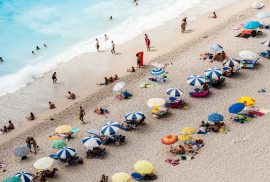The process of marriage in Indonesia the society recognizes in term of dowry (mahr) for both brides. Dowry (mahr) is a property given to a woman from a man when he wants to marry the woman. In Toba-Batak custom, dowry is similar to sinamot. However, the distinguish dowry is not used for the cost of the wedding ceremony. Meanwhile, sinamot means” buying” – the woman he wants to marry from her family and for the wedding ceremony (Manurung, N. 2015, p. 33). Unlike Sinamot, Marhata Sinamot is an event in determining the amount of sinamot that will be given to women and whole of sinamot is used as the capital to make the wedding ceremony and as the purchase price of women. There is no specific formula for Sinamot. It was determined at the time of Marhata Sinamot by considering several things, such as the education of women – the higher the education the more sinamot they were given, social status – the more Sinamot given by men to be considered as established person and more Sinamot accepted by women is considered as buying an established lady, and the last is the position of the families – if it comes from high clan will be more expensive, is that so. In this era, born as a woman is still unprivileged under the stigma of “women will belong to others” and makes women left behind, unwell educated, and various others discrimination (Levine, D. 2003).
September
Discussing LGBT (Lesbian, Gay, Bisexual, and Transgender) is still a controversial issue for Indonesian society by this time. The assumptions are constructed on the community tend to discriminate because they are often considered as the scum. All of that is due to the mindset of our society who still assume that LGBT is a deviant behavior their existence is often undesirable by society (Oetomo, 2013). However, no one would think that it turns out LGBT as one of the attractions for local and foreign tourists in Indonesia. LGBT Tourism Destination or called Pink Tourism is a term for LGBT travel (Huges, 2006) where not a new phenomenon, but its existence is not so highlighted by the wider community, particularly in Indonesia. It called Pink Tourism because pink color has been adopted by the homosexual community when the inverted pink triangle must be worn by gay men at Nazi Germany concentration camps at the time. So that, nowaday, phrase of pink tourism have been the term for tourist attractions which used LGBT as the main attraction (Ni Putu Diah Prabawati et al., 2019). Pink Tourism has become a natural thing for countries in Europe such as Spain, France, Germany, and the Netherlands, but not for Indonesia (UNWTO, 2012). Indonesia for this far has only been mostly recognized by its tourism sector in term of natural and ethnicity. However, it turns out that we keep taboo tourism in the society called LGBT tourism. Many tourists want to visit Indonesia because they want to feel this Indonesia LGBT tourism. Two regions as the most popular tourism in Indonesia also store lucrative LGBT tourism, which is Yogyakarta and Bali. Indonesia is truly rich with its tourist attractions where all over parts of Indonesia has its attractiveness. However, as we know from all of that Special Region of Yogyakarta and Bali are the most want to visit places in Indonesia. This two well-known regions not only provide a beautiful landscape and ethnicity but also amazing and interesting Pink Tourism for their tourists.


